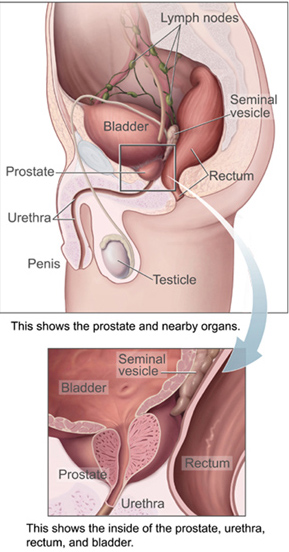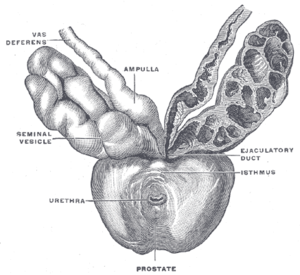Prostate: Difference between revisions
| [pending revision] | [pending revision] |
Undid revision 160179668 by 24.19.251.52 (talk) |
|||
| Line 148: | Line 148: | ||
* {{SUNYAnatomyFigs|44|04|06}} - "Mid-sagittal section of the male pelvis." |
* {{SUNYAnatomyFigs|44|04|06}} - "Mid-sagittal section of the male pelvis." |
||
*[http://www.medical-animations.com/video.php?num=44&type=swf "Virtual Prostate"] animation by [[George Washington University]] Medical Center |
*[http://www.medical-animations.com/video.php?num=44&type=swf "Virtual Prostate"] animation by [[George Washington University]] Medical Center |
||
*[http://www.thehealthyprostate.com/anatomy "Simple Prostate Anatomy Animation and Information about Prostate Massage"] |
|||
* {{ViennaCrossSection|pelvis/pelvis-e12-15}} |
* {{ViennaCrossSection|pelvis/pelvis-e12-15}} |
||
</div> |
</div> |
||
Revision as of 23:00, 1 October 2007
| Prostate | |
|---|---|
 Male Anatomy | |
 Prostate with seminal vesicles and seminal ducts, viewed from in front and above. | |
| Details | |
| Precursor | Endodermic evaginations of the urethra |
| Artery | internal pudendal artery, inferior vesical artery, and middle rectal artery |
| Vein | internal iliac vein |
| Nerve | inferior hypogastric plexus |
| Lymph | external iliac lymph nodes, internal iliac lymph nodes |
| Identifiers | |
| Latin | prostata |
| MeSH | D011467 |
| TA98 | A09.3.08.001 |
| TA2 | 3637 |
| FMA | 9600 |
| Anatomical terminology | |
The prostate is a compound tubuloalveolar exocrine gland of the male mammalian reproductive system.
The prostate differs considerably among species anatomically, chemically, and physiologically.
Relations
- Posterior: rectum
- Superior: urinary bladder
- Anterior: pubic symphysis
- Inferior: upper surface of urogenital diaphragm
- Lateral: anterior fibers of levator ani muscle
Function
The main function of the prostate is to store and secrete a clear, slightly alkaline (pH 7.29) fluid that constitutes 10-30% of the volume of the seminal fluid that, along with spermatozoa, constitutes semen. The rest of the seminal fluid is produced by the two seminal vesicles.
The prostate also contains some smooth muscles that help expel semen during ejaculation.
Secretions
Prostatic secretions vary among species. They are generally composed of simple sugars, and are often slightly basic.
In human prostatic secretions, the protein content is less than 1% and includes proteolytic enzymes, acid phosphatase, and prostate-specific antigen. The secretions also contain zinc and citric acid.
Regulation
To work properly, the prostate needs male hormones (androgens), which are responsible for male sex characteristics.
The main male hormone is testosterone, which is produced mainly by the testicles. Some male hormones are produced in small amounts by the adrenal glands.However, it is dihydrotestosterone that regulates the prostate.
Development
The prostate gland represents the modified wall of the proximal portion of the male urethra and arises by the 9th week of embryonic life in the development of the reproductive system. Condensation ofmesenchyme, urethra and Wolffian ducts gives rise to the adult prostate gland, a composite organ made up of several glandular and non-glandular components tightly fused within a common capsule.
Skene's glands found in many females are homologous to the prostate gland in males.
Structure
A healthy human prostate is slightly larger than a walnut. It surrounds the urethra just below the urinary bladder and can be felt during a rectal exam.
The ducts are lined with transitional epithelium.
Within the prostate, the urethra coming from the bladder is called the prostatic urethra and merges with the two ejaculatory ducts. (The male urethra has two functions: to carry urine from the bladder during urination and to carry semen during ejaculation.)
The prostate can be divided in two different ways: by zone, or by lobe.
Zones
The "zone" classification is more often used in pathology.
The prostate gland has four distinct glandular regions, two of which arise from different segments of the prostatic urethra:
| Name | Percent | Description |
| Peripheral zone (PZ) | Composes up to 70% of the normal prostate gland in young men | The sub-capsular portion of the posterior aspect of the prostate gland which surrounds the distal urethra. It is from this portion of the gland that more than 70% of prostatic cancers originate. |
| Central zone (CZ) | Constitutes approximately 25% of the normal prostate gland | This zone surrounds the ejaculatory ducts. Central zone tumours account for more than 25% of all prostate cancers. |
| Transition zone (TZ) | Responsible for 5% of the prostate volume | This zone is very rarely associated with carcinoma. The transition zone surrounds the proximal urethra and is the region of the prostate gland which grows throughout life and is responsible for the disease of benign prostatic enlargement. |
| Anterior fibro-muscular zone (or stroma) | Accounts for approximately 5% of the prostatic weight | This zone is usually devoid of glandular components, and composed only, as its name suggests, of muscle and fibrous tissue. |
Lobes
The "lobe" classification is more often used in gross anatomy.
| Anterior lobe (or isthmus) | roughly corresponds to part of transitional zone |
| Posterior lobe | roughly corresponds to peripheral zone |
| Lateral lobes | spans all zones |
| Median lobe (or middle lobe) | roughly corresponds to part of central zone |
Prostate disorders
Prostatitis
Prostatitis is inflammation of the prostate gland. There are different forms of prostatitis, each with different causes and outcomes. Acute prostatitis and chronic bacterial prostatitis are treated with antibiotics; chronic non-bacterial prostatitis or male chronic pelvic pain syndrome, which comprises about 95% of prostatitis diagnoses, is treated by a large variety of modalities including alpha blockers, phytotherapy, physical therapy, psychotherapy, antihistamines, anxiolytics, nerve modulators and more.[1] More recently, a combination of trigger point and psychological therapy has proved effective as well.[2]
Benign prostatic hyperplasia
Benign prostatic hyperplasia (BPH) occurs in older men; the prostate often enlarges to the point where urination becomes difficult. If the prostate grows too large it may constrict the urethra and impede the flow of urine, making urination difficult and painful and in extreme cases completely impossible. BPH can be treated with medication or with surgery that removes part of the prostate. The surgery most often used in such cases is called transurethral resection of the prostate (TURP or TUR). In TURP, an instrument is inserted through the urethra to remove prostate tissue that is pressing against the upper part of the urethra and restricting the flow of urine. Older men often have corpora amylacea[3] (amyloid), dense accumulations of calcified proteinaceous material, in the ducts of their prostates. The corpora amylacea may obstruct the lumens of the prostatic ducts, and may underlie some cases of BPH.
Urinary frequency due to bladder spasm, common in older men, may be confused with prostatic hyperplasia (enlarged prostate.)
Prostate cancer
Prostate cancer is one of the most common cancers affecting older men in developed countries and a significant cause of death for elderly men (estimated by some specialists at 3%). Regular rectal exams are recommended for older men to detect prostate cancer early.
Male sexual response
During orgasm sperm are transmitted from the ductus deferens into the male urethra via the ejaculatory ducts, which lie within the prostate gland.
The prostate is often referred to as the male g-spot. Some men are able to achieve orgasm solely through stimulation of the prostate gland. Men who report the sensation of prostate stimulation often give descriptions similar to women's accounts of G-spot stimulation.[4]
Additional images
-
Urinary bladder
-
Structure of the penis
-
Lobes of prostate
-
Zones of prostate
-
Prostate
-
Prostate under a microscope This image shows the microscopic glands of the prostate
-
Male Anatomy
-
The deeper branches of the internal pudendal artery.
-
Lymphatics of the prostate.
-
Fundus of the bladder with the vesiculæ seminales.
-
Vesiculae seminales and ampullae of ductus deferentes, seen from the front.
-
Vertical section of bladder, penis, and urethra.
Vasectomy and risk of prostate cancer
In 1993, the Journal of the American Medical Association revealed a connection between vasectomy and an increased risk of prostate cancer. Reported studies of 48,000 and 29,000 men who had vasectomies showed 66 percent and 56 percent higher rates of prostate cancer, respectively. The risk increased with age and the number of years since the vasectomy was performed.
However, in March of the same year, the National Institute of Child Health and Human Development held a conference cosponsored by the National Cancer Institute and others to review the available data and information on the link between prostate cancer and vasectomies. It was determined that an association between the two was very weak at best, and even if having a vasectomy increased one's risk, the risk was relatively small.
In 1997, the NCI held a conference with the prostate cancer Progressive Review Group (a committee of scientists, medical personel, and others). Their final report, published in 1998 stated that evidence that vasectomies help to develop prostate cancer was weak at best.[5]
References
The text of this article was originally taken from NIH Publication No. 02-4806, a public domain resource [1].
- ^ "Pharmacological treatment options for prostatitis/chronic pelvic pain syndrome" (html). 2006. Retrieved 2006-12-11.
- ^ Anderson RU, Wise D, Sawyer T, Chan CA. (2006). "Sexual dysfunction in men with chronic prostatitis/chronic pelvic pain syndrome: improvement after trigger point release and paradoxical relaxation training". J Urol. 176 (4 Pt 1): 1538-9.
{{cite journal}}: CS1 maint: multiple names: authors list (link) - ^ "Slide 33: Prostate, at ouhsc.edu". Retrieved 2007-08-16.
- ^ Ladas, AK. The G spot and other discoveries about human sexuality. New York: Holt, Rinehart, and Winston.
{{cite book}}: Unknown parameter|coauthors=ignored (|author=suggested) (help) - ^ http://www.cancer.gov/cancertopics/factsheet/Risk/vasectomy
External links
- Active Sex Life Seen as Protecting Prostate from NPR.org
- "What I need to know about prostate problems" by the US National Institutes of Health.
- "Drug hope in prostate cancer care", from BBC News
- "Prostatic specialist surgeon"
- UK Prostate Link
- Men's Health NZ Information on prostate health and testosterone
- Anatomy figure: 44:04-06 at Human Anatomy Online, SUNY Downstate Medical Center - "Mid-sagittal section of the male pelvis."
- "Virtual Prostate" animation by George Washington University Medical Center
- "Simple Prostate Anatomy Animation and Information about Prostate Massage"
- Cross section image: pelvis/pelvis-e12-15—Plastination Laboratory at the Medical University of Vienna











